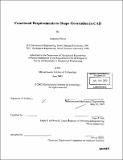| dc.contributor.advisor | Nam P. Suh. | en_US |
| dc.contributor.author | Chung, Jinpyung, 1967- | en_US |
| dc.contributor.other | Massachusetts Institute of Technology. Dept. of Mechanical Engineering. | en_US |
| dc.date.accessioned | 2006-03-24T16:09:27Z | |
| dc.date.available | 2006-03-24T16:09:27Z | |
| dc.date.copyright | 2002 | en_US |
| dc.date.issued | 2003 | en_US |
| dc.identifier.uri | http://hdl.handle.net/1721.1/29628 | |
| dc.description | Thesis (Ph. D.)--Massachusetts Institute of Technology, Dept. of Mechanical Engineering, June 2003. | en_US |
| dc.description | Includes bibliographical references (p. 119-121). | en_US |
| dc.description.abstract | An outstanding issue in computer-aided design (CAD) is the creation of geometric shapes from the description of functional requirements (FRs). This thesis presents a method that can generate assembled shapes from the given FRs without human intervention. To achieve this goal, the design process follows a V-model of decomposition and integration based on axiomatic design. The V-model consists of three main sub-processes; (1) a top-down decomposition of FRs and design parameters (DPs), (2) mapping of DPs into geometric entities, and (3) a bottom-up integration of the geometric entities. A shape decomposition technique is used in the V-model to generate solid cells from the geometric entities in the CAD models based on FRs. These cells are stored and reused during the integration process. A set of cells mapped to an FR is called a functional geometric feature (FGF) to differentiate it from geometric features defined by only geometric characteristics. Each FGF has mating faces as its pre-defined interfaces. Links of FR-DP-FGF-INTERFACES and their hierarchies are made and stored in the database as fundamental units for automatic assembled shape generation. The retrieval of proper FGF from the database is performed by matching a query FR with stored FRs by a lexical search based on the frequency of words and the sequence of the words in the FR statements using a synonym checking system. The language-matching rate is calculated as a value of FRmetric between 0 and 1. A computer algorithm automatically combines and assembles the retrieved FGFs. Genetic algorithm (GA) searches for the best combination for matching interface types and generates assembly sequences. | en_US |
| dc.description.abstract | (cont.) From the highest-valued chromosome, the computer algorithm automatically assembles FGFs by coordinating, orienting, and positioning with reference to the given mating conditions and calculates geometric interface-ability to a value of INTERFACEmetric between 0 and 1. The higher the values of FRmetric and INTERFACEmetric, the better the generated design solution for the given FRs that must be satisfied. The process of top-down decomposition and bottom-up integration reduces the number of possible combinations of interfacing FGFs. Design matrix visually relates FRs to FGFs. The method presented in this thesis has demonstrated that a "functional CAD" can aid designers in generating conceptual design solutions from functional descriptions, in reusing existing CAD models, and in creating new designs. | en_US |
| dc.description.statementofresponsibility | by Jinpyung Chung. | en_US |
| dc.format.extent | 121 p. | en_US |
| dc.format.extent | 4322813 bytes | |
| dc.format.extent | 4322621 bytes | |
| dc.format.mimetype | application/pdf | |
| dc.format.mimetype | application/pdf | |
| dc.language.iso | eng | en_US |
| dc.publisher | Massachusetts Institute of Technology | en_US |
| dc.rights | M.I.T. theses are protected by copyright. They may be viewed from this source for any purpose, but reproduction or distribution in any format is prohibited without written permission. See provided URL for inquiries about permission. | en_US |
| dc.rights.uri | http://dspace.mit.edu/handle/1721.1/7582 | |
| dc.subject | Mechanical Engineering. | en_US |
| dc.title | Functional requirements to shape generation in CAD | en_US |
| dc.type | Thesis | en_US |
| dc.description.degree | Ph.D. | en_US |
| dc.contributor.department | Massachusetts Institute of Technology. Department of Mechanical Engineering | |
| dc.identifier.oclc | 53370767 | en_US |
